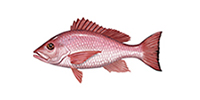Thank you for visiting the Seafood Selector. EDF is planning a new approach to providing information to consumers about good seafood choices. Please come back soon for updates.
Snapper

Red snapper
Recommended servings per month
| Contaminant | Men | Women | Kids 6-12 | Kids 0-5 | |
|---|---|---|---|---|---|
| Imported snapper | Mercury | 4+ | 4+ | 3 | 2 |
| Lane snapper | Mercury | 3 | 4+ | 2 | 1 |
| Red snapper (Gulf of Mexico) | Mercury | 4+ | 4+ | 3 | 2 |
| Silk snapper | Mercury | 4+ | 4+ | 3 | 2 |
| Vermilion snapper | Mercury | 4+ | 4+ | 3 | 2 |
| Yellowtail snapper | Mercury | 4+ | 4+ | 4 | 3 |
| Mutton snapper | Mercury | 3 | 3 | 2 | 1 |
Eco details:
- Management of snapper in most of the world is poor, and has resulted in overfishing of many populations
- Gulf of Mexico red snapper has been caught under an innovative catch share management plan since 2007. Populations have increased significantly, while fishermen have also reduced discards by 50%. As a direct result, Gulf commercial red snapper fishermen have seen a 60% increase in their quotas since the program began.




